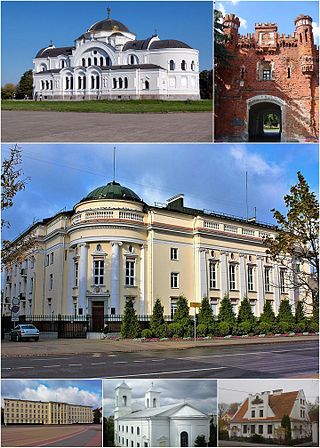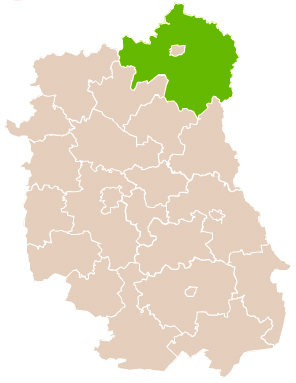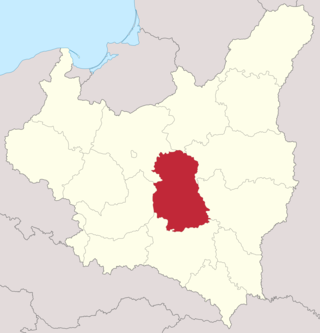A voivodeship or voivodate is the area administered by a voivode (governor) in several countries of central and eastern Europe. Voivodeships have existed since medieval times and the area of extent of voivodeship resembles that of a duchy in western medieval states, much as the title of voivode was equivalent to that of a duke. Other roughly equivalent titles and areas in medieval Eastern Europe included ban and banate.

Brest, formerly Brest-Litovsk and Brest-on-the-Bug, is a city in Belarus at the border with Poland opposite the Polish town of Terespol, where the Bug and Mukhavets rivers meet, making it a border town. It serves as the administrative center of Brest Region and Brest District, though it is administratively separated from the district. As of 2023, it has a population of 342,461.

Volyn Oblast or simply Volyn is an oblast (province) in northwestern Ukraine. It borders Rivne Oblast to the east, Lviv Oblast to the south, Poland to the west and Belarus to the north. Its administrative centre is Lutsk. Kovel is the westernmost town and the last station in Ukraine on the rail line running from Kyiv to Warsaw. The population is 1,021,356.

The Lublin Voivodeship, also known as the Lublin Province, is a voivodeship (province) of Poland, located in southeastern part of the country. It was created on January 1, 1999, out of the former Lublin, Chełm, Zamość, Biała Podlaska and (partially) Tarnobrzeg and Siedlce Voivodeships, pursuant to Polish local government reforms adopted in 1998. The region is named after its largest city and regional capital, Lublin, and its territory is made of four historical lands: the western part of the voivodeship, with Lublin itself, belongs to Lesser Poland, the eastern part of Lublin Area belongs to Red Ruthenia, and the northeast belongs to Polesie and Podlasie. Lublin Voivodeship borders Subcarpathian Voivodeship to the south, Świętokrzyskie Voivodeship to the south-west, Masovian Voivodeship to the west and north, Podlaskie Voivodeship along a short boundary to the north, Belarus and Ukraine to the east. The region's population as of 2019 was 2,112,216. It covers an area of 25,155 square kilometres (9,712 sq mi).

Terespol is a border town in eastern Poland on the border with Belarus. It lies on the border river Bug, directly opposite the city of Brest, Belarus. It has 5,794 inhabitants as of 2014.

Biała Podlaska is a city in eastern Poland with 56,498 inhabitants as of December 2021. It is situated in the Lublin Voivodeship, having previously been the capital of Biała Podlaska Voivodeship (1975–1998). It is the capital of Biała Podlaska County, although the city is not part of the county. The city lies on the Krzna river.

Chełm is a city in southeastern Poland with 60,231 inhabitants as of December 2021. It is located to the south-east of Lublin, north of Zamość and south of Biała Podlaska, some 25 kilometres from the border with Ukraine. Chełm used to be the capital of the Chełm Voivodeship until it became part of the Lublin Voivodeship in 1999.

Red Ruthenia, or Red Rus' , is a term used since the Middle Ages for the south-western principalities of the Kievan Rus', namely the Principality of Peremyshl and the Principality of Belz. Nowadays the region comprises parts of western Ukraine and adjoining parts of south-eastern Poland. It has also sometimes included parts of Lesser Poland, Podolia, Right-bank Ukraine and Volhynia. Centred on Przemyśl and Belz, it has included major cities such as: Chełm, Zamość, Rzeszów, Krosno and Sanok, as well as Lviv and Ternopil.

Volhynia, is a historic region in Central and Eastern Europe, between southeastern Poland, southwestern Belarus, and western Ukraine. The borders of the region are not clearly defined, but the territory that still carries the name is Volyn Oblast, in western Ukraine.

Lutsk is a city on the Styr River in northwestern Ukraine. It is the administrative center of Volyn Oblast and the administrative center of Lutsk Raion within the oblast. Lutsk has a population of 215,986. Historically it was a cultural and religious center in Volhynia.

Włodawa County is a unit of territorial administration and local government (powiat) in Lublin Voivodeship, eastern Poland, on the border with Ukraine and Belarus. It was established on January 1, 1999, as a result of the Polish local government reforms passed in 1998. Its administrative seat and only town is Włodawa, which lies 76 kilometres (47 mi) north-east of the regional capital Lublin.

Biała County is a county in Lublin Voivodeship, eastern Poland, on the border with Belarus. It was established on January 1, 1999, as a result of the Polish local government reforms passed in 1998. Its administrative seat is the city of Biała Podlaska, although the city is not part of the county. The only towns in Biała Podlaska County are Międzyrzec Podlaski, which lies 24 km (15 mi) west of Biała Podlaska, and the border town of Terespol, 32 km (20 mi) east of Biała Podlaska.

Lublin Voivodeship was a unit of administrative division of the Second Polish Republic between the two world wars, in the years 1919–1939. The province's capital and biggest city was Lublin.

Kodeń is a village in eastern Poland on the Bug River, which forms the border between Poland and Belarus. Administratively, it belongs to Biała Podlaska County in Lublin Voivodeship. It is the seat of the gmina called Gmina Kodeń. It has approximately 1,900 inhabitants. It lies approximately 37 kilometres (23 mi) south-east of Biała Podlaska and 102 km (63 mi) north-east of the regional capital Lublin. The village is the site of a famous Marian shrine.
Gmina Janów Podlaski is a rural gmina in Biała Podlaska County, Lublin Voivodeship, in eastern Poland, on the border with Belarus. Its seat is the village of Janów Podlaski, which lies approximately 20 kilometres (12 mi) north of Biała Podlaska and 115 km (71 mi) north-east of the regional capital Lublin.
Gmina Rokitno is a rural gmina in Biała Podlaska County, Lublin Voivodeship, in eastern Poland on the border with Belarus. Its seat is the village of Rokitno which lies approximately 15 kilometres (9 mi) north-east of Biała Podlaska and 109 km (68 mi) north-east of the regional capital Lublin.

Kostomłoty is a village in the administrative district of Gmina Kodeń, within Biała Podlaska County, Lublin Voivodeship, in eastern Poland, close to the border with Belarus.

Kukuryki is a village in the administrative district of Gmina Terespol, within Biała Podlaska County, Lublin Voivodeship, in eastern Poland, close to the border with Belarus. It lies approximately 3 kilometres (2 mi) north of Terespol, 32 km (20 mi) east of Biała Podlaska, and 118 km (73 mi) north-east of the regional capital Lublin.

A Dowództwo Okręgu Korpusu was a military district of the Ministry of Military Affairs of the Second Polish Republic. It served as an organizational, mobilisational, and administrative body of the Polish Army and all local military units of the country were subject to the Corps commands. Also, the DOKs ran all Military Draft Offices of Poland. The system of DOKs was modeled after the French Army, and according to Polish planners, each district located along either Soviet or German border was supposed to field one army. It meant that all districts except for District X, were subject to this rule. The borders of the DOKs did not reflect the Administrative division of Second Polish Republic.

Chełm is a Polish parliamentary constituency in the Lublin Voivodeship. It elects twelve members of the Sejm.

















